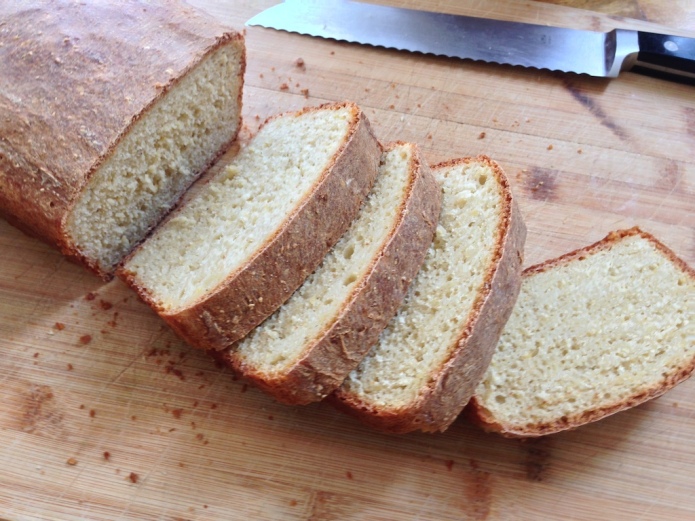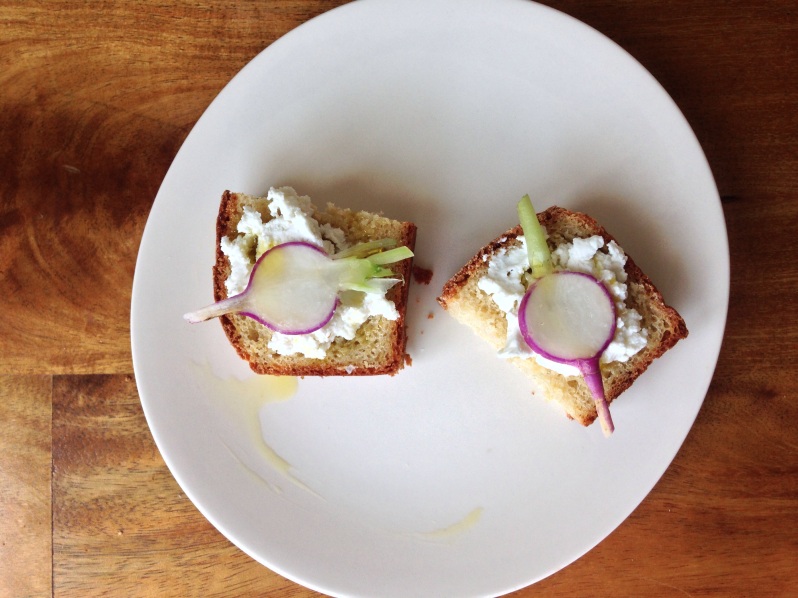Clostridium perfringens […] can eat flesh. It gives gas gangrene its name by causing putrefying flesh wounds that bubble and foam with flammable hydrogen. And it can make something surprisingly delicate and tasty.” Harold McGee on salt-rising bread
My most favorite food publication is Lucky Peach. It’s a quarterly magazine that explores one food theme per issue, both in unconventional ways (diatribes, musings, cartoons) and expected ways (recipes, travel journals etc). It’s equal parts madcap, avant garde, topical and historical. I do a little jig when a new issue arrives in my mailbox (as in, old timey snail mail).
The most recent issue of Lucky Peach included an article by Food Scientist extraordinaire, Harold McGee, about making bread using Clostridium perfringens, a close relative of the bacteria that cause botulism, tetanus, and food poisoning. The bread is leavened by encouraging bacterial growth and the gas created by the bacteria causes the dough to rise. The bread is called salt-rising bread and clearly I had to make some.
Salt-rising bread, or SRB as it is lovingly known, is an example of pioneer can do spirit! It has its roots in the 19th century American frontier when keeping a starter cool was difficult, and fresh yeast was hard to come by. It is still quite popular in Appalachia, western New York, western Pennsylvania, and parts of Michigan. SRB is available in bakeries in these parts of the country, and you can even buy it online from Rising Creek Bakery in Morris, Pa.
The origins of the name salt rising bread are unclear. Some attribute the name to the fact that it rises due to the salt-tolerant bacteria present in the starter (although this would be anachronistic and not all recipes call for salt). Another theory is that pioneer women kept their dough warm in a salt barrel as they crossed the country on wagon. A third theory postulates that chunks of salt, often kept next to the hearth in a salt box, were used to provide the warmth necessary to nurture a starter overnight.
I am going to throw my hat into the ring and offer up a purely speculative and wholly unsubstantiated theory as to how salt rising bread got its name: I posit that maybe the name comes from the saleratus that was a go-to leavening agent during the early pioneer era, and a common ingredient in salt-rising bread. Although bacteria was discovered in the 1600’s, it wasn’t embraced by the medical establishment until the mid 1800’s. At the time salt rising bread was first being made people still thought you got sick from “vapors” and the like. They were feeding and nurturing bacteria to create the rise in salt-rising bread, but they didn’t know that. However, they did know that adding saleratus to the starter or the dough helped the rise.
Saleratus comes from the Latin and means aerated salt. (aerated salt= salt-rising bread???) It was a precursor to baking soda, which most (but not all) modern SRB recipes call for either in the starter or in the sponge. While I could not find a primary source recipe dating from the pioneer era, Susan Brown, who is one of the foremost experts on the history of salt-rising bread, did confirm that saleratus would have been used in the original recipes. Her website is full of recipes, history and anecdotes about Salt-Rising Bread.
I poured through a hundred or so recipes for SRB and almost all of them mentioned the unusually “cheesy” smell of the starter and of the finished loaf. While some sources compared the smell to dirty socks others discretely just called it “pungent”, I thought the most poetic description was from J.C. Furnas in The Americans: A Social History of the US, 1587-1914: “Indeed it is, when at its best, as if a delicately reared, unsweetened plain cake had had an affair with a Pont l’Eveque cheese.”
I wasn’t expecting this recipe to work on the first try. Almost every recipe I found came with the warning that this was a persnickety undertaking. For example, the description of SRB in The James Beard cookbook reads: “you may try the same recipe three of four times without success to find that it works the fifth time. Or you may get a loaf that is halfway good.” Well, that does not inspire confidence.
The reason for the failure rate is that it is difficult to keep the starter at a relatively consistent warm temperature (110 degrees would be ideal). Some clever people put their starter in a yogurt maker, or wrap it lovingly in a heating pad. Those options were not available to me, so I just did my best to MacGuyver my way through it.
There have been no known instances of SRB causing anyone to fall ill. That said, Harold McGee advises not to lick the spoon or eat the dough before it’s cooked.
SALT-RISING BREAD
note: my bread turned out great on my first attempt! I set my oven to its lowest setting for 5 minutes, then turned off the heat, opened the door for one minute then put the starter inside overnight.
note 2: SRB is easy to digest! The chemical processes by which the flour is broken down appear to be more complete in Salt-Rising Bread than in ordinary breads. Consequently, this bread along with sprouted grain breads and sourdoughs is believed to be particularly easy to digest.
yield: 2 loaves
time: 1 1/2 days (it’s a SLOW rise)
ingredients for starter:
1 cup cornmeal
1 tablespoon sugar
1 teaspoon salt
2 cups milk
technique:
1.Combine dry ingredients in a bowl or large jar.
2.Boil milk and pour over dry ingredients.
3.Stir to incorporate wet and dry. Cover loosely and keep warm, 100 to 110º F, for 8 to 10 hours.
ingredients for the sponge:
1 teaspoon baking soda
1 cup water, warm but not hot
the starter
2 cups AP flour
technique:
1.Combine baking soda, water and starter.
2.Stir in flour to make a thick batter. Cover and keep warm again for 3 to 4 hours, until the batter is spongy with bubbles.
ingredients for the bread:
1 teaspoon salt
the sponge
3 to 4 cups AP flour
1.Add salt into sponge
2.Knead in enough flour to make a resilient dough.
3.Divide the dough between 2 greased loaf pans. Rise in a warm place until the volume has doubled, 2 to 6 hours.
4.Preheat oven to 425º F. Bake the loaves for 45 minutes or until nicely browned. Remove loaves from pans and cool on rack.
The Taste– Totally delicious. My loaf tasted like cheesy corn bread. The texture was dense and chewy and extremely satisfying. I ate it with butter, then with ricotta and radishes. Last but not least- lightly toasted with blueberry jam.
The Process– This bread takes a long time. And it’s anxiety producing! The hardest part is waiting to see if the starter is successful. You let it sit for 8-10 hours initially, but the starter doesn’t look like much. It’s not until you mix in flour and water and let it sit another 4 hours or so will you see signs of life. My stomach was in knots, and I was prepared for failure. Also worth noting- I did not find the starter or the baked loaf to be especially pungent, just mildly cheesy.
The Verdict– Totally worth it! If I had had to make it 4 or 5 times before succeeding (as James Beard warned I might have to) I might be singing a different tune. But it worked and the flavor is deliciously unique.


Looks yummy and reminds me of the 70’s when we shared sour dough starter with about 25 recipes of yummy things you could make, using the magical dough.
Looks delicious, I will wait for you to make it for me
That sounds really good and I want to make this now. The science of it is very interesting. I would like to try it.
It’s so delicious, Andrew! You will love it. Please keep me updated about how yours turns out! p.s. Congratulations on your blog!
why do you identify the rising bacteria as Clostridium perfringens? how do you know that? Thanks.
The bacteria was identified by Harold McGee, food scientist extraordinaire!
I love SRB but it’s hard to find a bakery that really bakes it with the rich cheesy flavor. I have 2 questions though… 1) can Self rising flour be used? & 2) could sour milk be scalded for this?
Amazing to find such a resource online, thanks for posting this along with a recipe. My instant pot with the yogurt setting helped maintain the temperature necessary for this bread.